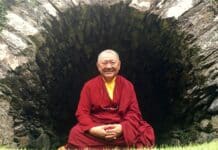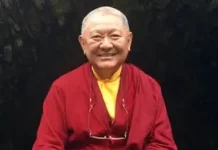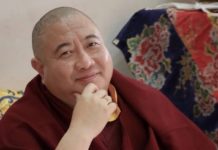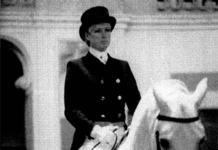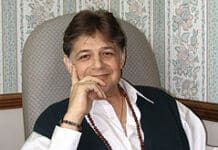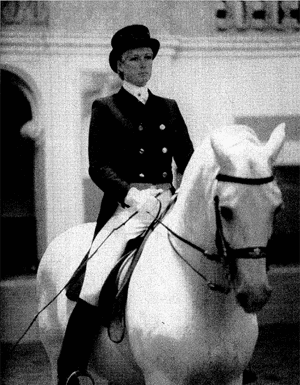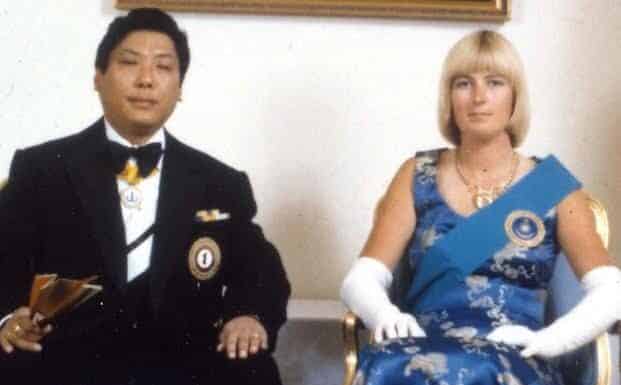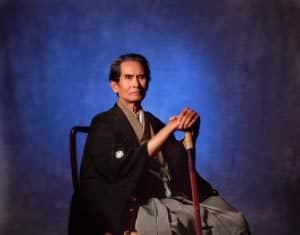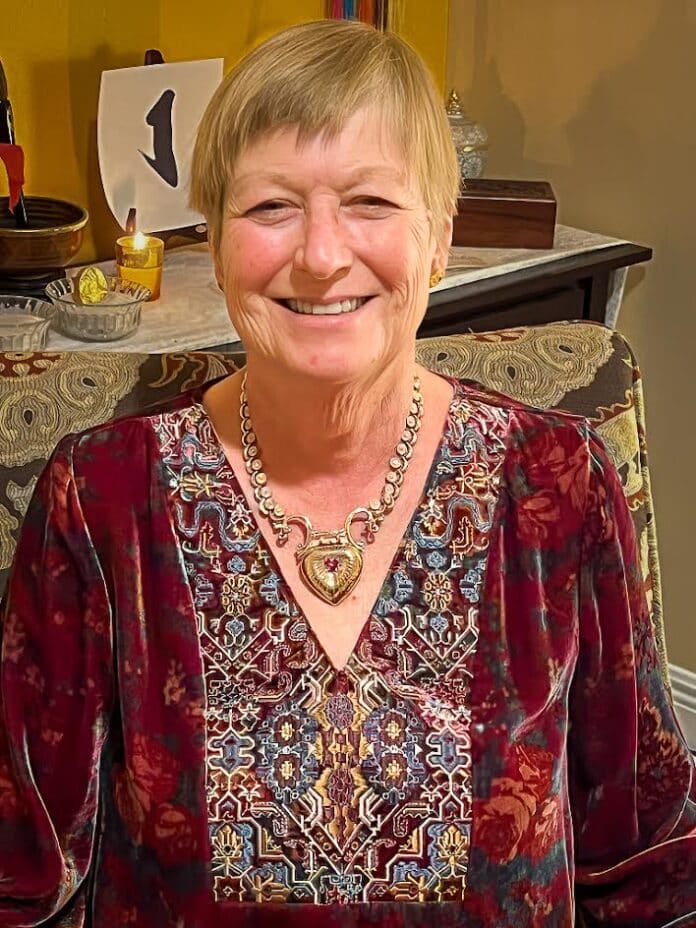
I’ve been asked by the family of Lady Diana Mukpo to make some remarks today about her life story: who she was, what she did and what her connection is to all of us! It’s difficult to do this for someone of her stature and also for someone who was such a beloved friend of many years.
Lady Diana, wife of Chogyam Trungpa Rinpoche and accomplished in so many ways on her own, is really the mother of Shambhala. I say this because she dedicated every ounce of her being to supporting the Vidyadhara Chogyam Trungpa in establishing the Practice Lineage in North America and from there spreading around the world.
I want to start by thanking her for protecting the legacy of Trungpa Rinpoche and for providing the access to and safeguarding availability of his teachings for close to 40 years since his death. He left her all the rights to his writings and other creations and gave her the burden of caring for all of these intellectual properties, which were vast. Not only does this cover his published books, but it covers all the recorded teachings he gave, which are now being made accessible by the Chogyam Trungpa Institute, his poetry, his visual designs, his paintings and so many other things that he created. It includes all of his writings in both English and Tibetan. He also asked her to care for his household and religious objects — a big agenda. He didn’t leave her these things so that she could enrich herself or be treated as an important person, but I believe he took this approach because he knew that she would never give in and never give up protecting and promoting his life’s work – to benefit all of us, not herself.
We owe her an unbelievable debt, one that many people have no idea about.
Diana was born Diana Judith Pybus at Queen Charlotte’s Hospital in London, England, on October 8th, 1953, at midnight on the new moon. Her mother, Elizabeth Pybus, grew up in South Africa and her father, David Pybus, was from a family of Barristers in England. She had an older sister, Tessa, with whom she was very close. I would recommend her memoir Dragon Thunder: My Life with Chogyam Trungpa to you. In many ways, Diana’s childhood resembled something out of Harry Potter or another such story set in England. While she was raised by her biological family and didn’t have to live in a closet as Harry did, she felt alienated and often depressed by the constricting world she grew up in. Her mother wanted her to become a proper English young woman. Diana was sent to a number of English boarding schools. You can visualize them if you’ve seen Harry Potter or other films. No magical moving staircases, but certainly very eccentric people and intense situations. She was in Guilford House at Benenden, by the way. She attended boarding school with Princess Anne of England and Sonam and Dechen, princesses of Bhutan. These schools were those kinds of places.
In her case, she didn’t find fulfillment in this education. She found it stifling and soul snatching, one might say. The saving grace was, perhaps, that she began riding as a child and continued this while at school.
She became interested in Buddhism as a teenager and what was then called Eastern Religion. Here is how she described meeting Chogyam Trungpa Rinpoche, putting it in context of who he was:
Rinpoche was one of the first Tibetan Buddhist teachers in the West and one of the very first to teach Westerners in the English language. The time that he spent in the West—between 1963, when he arrived in England, and 1987, when he died in North America—was an important period for the transplantation of Buddhism to the West, and I hope that my viewpoint as his wife may offer a unique perspective on that period. A lot of what my life was about during those years was about him and what happened to him. So a main objective for telling my story is so that the memory of him and of all those things that happened can be preserved.
I also want to talk about our life together and our relationship because it was so human and so intimate. Ultimately, I think that this is the essence of the Buddhist teachings: they are about how to live our lives as human beings, intimately, moment by moment. So I will try to share with you what it was really like to love such a person. It was quite extraordinary.
In the autumn of 1968, I read Born in Tibet, Rinpoche’s book about his upbringing in Tibet and his escape from Tibet. I thought it was an exciting and somewhat exotic story. However, the book was nowhere near as thrilling as meeting the author proved to be!
Over the Christmas holidays, I went to St. George’s Hall to attend a rally for the liberation of Tibet, sponsored by the Buddhist Society. The program went on for several hours, with one speaker after another. I found it quite boring. One of the last speakers on the schedule was the author of Born in Tibet, Chögyam Trungpa Rinpoche, who appeared onstage in the maroon and saffron robes of a Tibetan monk. I looked up at him from the audience, and much to my amazement, I felt an immediate and intense connection. Before he could say anything, however, he collapsed and was carried offstage. We were told that Rinpoche had taken ill, but I imagine that alcohol may have been involved.
Although he was only onstage for a few minutes, I knew that I had a very deep and old connection with him, and it stirred up a great deal of emotion for me. The only way I can describe this experience is that it was like coming home. Nothing in my life had hit me in such a powerful way. I said to myself, “This is what I’ve been missing all my life. Here he is again.” This wasn’t just some exciting, powerful experience. I knew him, and as soon as I saw him, I realized how much I’d been missing him.
From that moment on, I wanted desperately to meet him.
From Dragon Thunder, Chapter One.
And she did! Within the period of a year or so, she met Chogyam Trungpa, they fell in love, and they were married. He was 28, she was 16. They were both alienated in many ways from their original upbringing and culture. The marriage was unanticipated by her family and his Tibetan colleagues, shocking them – yet we are so very lucky that they found one another and made their way to America. It’s a gripping and extraordinary story. But it’s just one of many, and we don’t have all day!
In early 1970, Diana and Rinpoche moved to America by way of Canada, actually, where they spent several months. They then drove to Karme Choling, then named Tail of the Tiger. It was a very special place to both of them, and it’s no accident that it is the site where we are gathered today, virtually and in person to wish Lady Diana well on her journey and to celebrate her life. Being here the past couple of days, you can feel her presence and Rinpoche’s presence. Being here brings back many memories for some of us, about living here after the Vidyadhara died, for weeks until his cremation. For her daughter, Chandali, it reminds her of Diana marrying her and Eric in this very shrine room. For another family member, a memory of her processing into the shrine room. It’s been a powerful and potent time.
Once they arrived in America, Rinpoche almost immediately began giving lectures and seminars. He was crisscrossing the continent, giving hundreds of talks a year in places as diverse as Los Angeles, Minneapolis, Kansas City, Seattle, Toronto, New York, Atlanta and tens of other places. He and Diana moved to Boulder, Colorado in 1971, where their two children, Tagtruk and Gesar, were both born.
These early years in Boulder were a rich, exciting, and a really fun time for many of us. – ask someone around you today to talk about the old days, in Boulder and wherever they lived, especially if you don’t know about those times. There are many great stories, more than we can possibly share.
In the earliest days, Diana took care of Rinpoche. She cooked for him, drove him, served as his secretary at times, and did countless tasks that later were taken over by his students. As things evolved, one of her many strengths was her willingness to accept whatever direction Rinpoche wanted to take and to step back and let him do it as he wanted and let his students play roles that helped him and brought them closer to him and to the teachings.
So Diana was both an important protagonist and a witness to much that went on in those days. She was also the confidante of the guru – someone with whom he shared many things never expressed to others. She also was never afraid to challenge him or to tell the truth as she saw it in any situation. She was an important counselor and guidepost.
As well, during the early years in Boulder, she was developing her skill as a rider. She was quite busy as a mother, raising Tagtruk, Gesar, and her stepson Osel Mukpo, who later became the Sakyong. There is a dramatic story of her rescuing Osel from England right after she became pregnant with her first son Taggie. It’s in the book. We don’t have time for the whole story but suffice it to say that it includes a dramatic taxi ride with lots of roadkill as she approached Samye-Ling.
Skipping ahead: Vajrayana entered the scene in full force in 1973 with the Vajradhatu Seminary. In 1974 Rinpoche and his students began Naropa Institute, which brought almost 2,000 seekers to Boulder in the summer of 74. Diana was actively involved in all of this.
As time went on, Diana had more time for herself and began to focus more on her training and discipline as a horsewoman, particularly in dressage. In 1976 she moved to California for some months to study with Charles De Kunffy. While she was living in the bay area, Trungpa Rinpoche came to California for the first visit to North America of His Holiness Dilgo Khyentse Rinpoche, who stayed with Diana as a guest in her house for some time.
During this visit, His Holiness identified Gesar as the reincarnation of Jamgon Kongtrul Rinpoche, and a ceremony was held at the dharmadhatu to enthrone him. He was 3 or 4 at the time. During this visit, also, Diana brought her German dressage teacher, Charles, with his partner Rod, to meet Rinpoche. They came by one night around midnight, dropping in on Trungpa Rinpoche. Charles and Rod were afraid that Rinpoche would have gone to sleep already, and they were astonished that Rinpoche was just sitting down to a formal dinner with silver candelabras and good china and crystal. They stayed for dinner. This was at the beginning of the era when the Shambhala world was beginning to take form.
In so many ways, Diana’s life and households coincided auspiciously with Trungpa Rinpoche’s many exploits. In 1977, while Rinpoche went on a yearlong retreat at Charlemont, Diana moved to Vienna to study dressage with Arthur Kottas, a very accomplished dressage rider at the Spanish Riding School. During his retreat, Rinpoche took a break and visited her. Somehow, after Rinpoche visited her there, the Spanish decided to enroll some international students. Diana applied and almost miraculously was accepted to the school. She is one of a handful of women in the history of the Spanish Riding school to be admitted.
The Shambhala teachings began to emerge in full force following the 1977 retreat, with terma texts, Ashe practice, and many other aspects of the Shambhala world beginning to arrive. During these years, Diana spent a lot of time helping Rinpoche to develop their house, now named the Kalapa Court, as a place where literally hundreds of students could learn more about living a fulfilling life – by being in the Shambhala household of Trungpa Rinpoche and Lady Diana. It was challenging for Lady Diana. It was during these years that Rinpoche insisted that she become Her Highness Lady Diana Mukpo. She wrote that, while this title bothered her a lot at first, she came to accept it. As she put it, “if we were going to live in a royal court, it wasn’t so bad for me to become a lady.”
Here is a poem that Trungpa Rinpoche wrote about Lady Diana and the Kalapa Court:
Hunting the Setting-Sun Moon
The Lady with the golden heart
Tinged with the power of juniper smoke–
We have been married for eleven years.
You are the luscious meadow
Filled with fresh greenness
And frolicking deer with good head and shoulders, as their pride.
When I am naughty,
You are kind,
You are so good,
Like the clouds, pure and good, they do not need to be put through a washing machine.
It is incredible that you put up with me.
You bear the mark of a unicorn.
Sometimes I wonder why you are so good to me.
Nonetheless, I try to be kind, good, and the best husband that the world
could ever provide.
You never hesitate to tell the truth when you see the falsity.
I have created the Court for you.
Undoubtedly you deserve it.
Your beauty is that you are never stained by the wickedness.
Being with you,
You are constant,
You are so predictable and yet you are so visionary.
Your breath smells of unstained truth.
Your smile is never meant to win others over.
O sweet Diana,
The huntress,
The rider,
Empress Lady, I live for you,
I die for you.
Up to this point, I have never had an opportunity to express my adoration.
The Lady of Life,
Lady who presides over the sun and moon,
You are the Lady who maintains integrity and truth.
You have never violated a single moment of truth since we married.
This is a parting gift in your praise:
We cry and laugh together in this mirror of the world.
Let us conquer the world and radiate the Great Eastern Sun.
My salutations to you:
I am your companion and humble servant.
Let us shoe the horses in the vajra style.
O queen of queens,
Let us share and have a jolly good life together,
Diana.
(Kalapa Court, 10 July 81. Used by permission)
In later years and after Trungpa Rinpoche’s death, Diana hoped to teach a number of programs that would present the skillful means of creating a household. She was only able to accomplish one program – at Karme Choling. In the year before her death, she was preparing to teach more of these programs.
Rinpoche’s last years were challenging – but Diana remained completely loyal and committed to him throughout. He wanted to establish Nova Scotia as the seat of his work. She moved there before he did, to help to create Nova Scotia as a legitimate home for the Shambhala teachings.
In 1983, Trungpa Rinpoche took another year of retreat, this time in Nova Scotia. During his retreat, Lady Diana received the Vajrayogini abhisheka from Trungpa Rinpoche. One of his poems written about this will be read at the Ceremony of Life later today.
After Rinpoche’s year of retreat, Diana lived in Boulder much of the time. (Although she still did some travel to pursue her dressage career in Europe.) She and the Vidyadhara moved the family to Halifax in September 1986, this time to the newly finished Kalapa Court on Young Avenue. Trungpa Rinpoche had a heart attack weeks after moving there. It was more than six months until his death on April 4, 1987.
Following his death, she stayed in Nova Scotia for a few years, but then moved away, first to Hawaii and then settled in Providence, Rhode Island. She married for a second time, to Mitchell Levy, who had been Trungpa Rinpoche’s doctor and a dear friend to Diana. They had three children, Ashoka, David and Chandali, who are all here today.
I want to mention that, In 2002, Diana travelled to Tibet with her three sons, her daughter, Mitchell and several close friends. At the Surmang Monastery where Rinpoche had presided, she gave an advanced Shambhala empowerment to hundreds of people. During her recent illness and at the time of her death, monks and nuns at Surmang conducted many ceremonies and did prayers for her. Tsoknyi Rinpoche’s nuns also did prayers, and there were other such offerings in other parts of Tibet and India. At the time of her death, Rapjam Rinpoche and Dzongsar Khyentse Rinpoche conducted ceremonies and sent other aides to help in her transition from this world. In recent years and months, Diana reached out to these and other Tibetan teachers, asking them to play a role in helping Rinpoche’s students in the future. She had reverence and tremendous respect for the Kagyu and Nyingma lineages in particular and strove to keep Shambhala and all of us connected to these important roots.
In later years, Diana spent many years or parts of the year in Florida, where she was very accomplished as a rider and trainer. She developed dear friends there, some of whom have joined us today by zoom or in person. She also developed a passion for orchids – and had hundreds in her garden. She never stopped caring for all beings, and this included bringing rescue dogs into her household. Luna the Malinois and Heruka the Mastiff can testify to this.
During Rinpoche’s lifetime, I was quite intimidated by Lady Diana. Following Rinpoche’s death, she asked me to work with her on the publication of Rinpoche’s books and other things. For example, one of her early requests was that we conserve and make prints of his paintings so that students could have copies.
I could talk for hours about our work together. But suffice it to say that, through serving her in this way – which I always viewed as a continuation of my service to the Vidyadhara – I came to see how deeply she cared about Trungpa Rinpoche’s legacy. She often operated in the background. Many people didn’t know how influential she was. She worked with the Board of Directors of Shambhala, was on the Board of the Chogyam Trungpa Institute at Naropa, advised the Shambhala Archives on its future, and helped to guide the Dorje Kasung and many other aspects of the Shambhala world.
I came to know her as one of the kindest people I’ve ever met and also one of the strongest. She never ceased caring about all of us, up to the moment of her death. When I visited her a few months before her death but after she had let us know that she was going into hospice, I thought that I would just be there with her to say goodbye. However, she wanted to have many discussions with me and others who were there – Ashoka, Lisa Fiore, Wendy Friedman, my husband Jim. She wanted to talk about how we would preserve Rinpoche’s teachings. That was truly what was on her mind. That and the overall welfare of her family and the sangha.
She was truly the Mother of the Shambhala world that we have grown up in.
I’d like to close by thanking those who helped care for her in her last days, especially Lisa Fiore, her Chief of Staff; Mitchell, her husband; David, Ashoka, and Chandali; and dear friends Heidi Mecklenburg and Jane Carpenter Cohn.
Thank you for allowing me to share a little of her life with you. I will miss her desperately, but I also know that I will feel her presence in the midst of her absence.
Carolyn Rose Gimian. September 17, 2025

